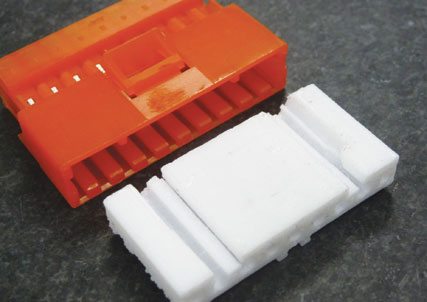Speeding Up Production
Xerox is the world’s leading enterprise in business processing and document management with sales of $22 billion. Recently, they introduced a low-volume printer to serve specialized markets that require a longer cable and additional features. The connector manufacturer needed a minimum order of 1 million units to retool for the new connector. Projected volume of the new printer was significantly less than the minimum order. Duane Byerley, Senior Model Maker at Xerox explains that “We found another cable that was long enough but the connectors did not fit the new printer . . . then we noticed that if we flipped the connector 180 degrees it came close to fitting. All that we needed to do was remove the ribs, a tab, and a clip. I pulled out an X-Acto knife and in about 20 minutes was able to cut away the extraneous geometry and make the connector work. But this approach was too slow, expensive and imprecise to make more than a few parts.”
A Fast Punch
With this in mind, Xerox required 350 connectors to be modified for testing. The first requirement was supporting the surface to be cut. Using the CAD file, Byerley created the negative of the existing connector geometry as the basis for an FDM piece that fits like a glove. The next step was building a punch. Byerley designed a two-piece FDM blade holder to carry four X-Acto blades in the U shape needed to punch out the extraneous geometry. He designed tapped holes into one of the FDM pieces so that two screws could be used to hold the assembly together. Then he designed a guide body to hold the connector and support and provide rails for the blade holder to slide on.
“FDM has a much broader application range. It works well in 90 percent of what we do, including making prototype parts, fixtures, tooling, injection molds and production parts. If you can imagine it and draw it in CAD, you can build it in FDM.” – Duane Byerley, Senior Model Maker, Xerox
An operator punched out the 350 pieces that were needed immediately in about an hour. Another operator installed them into prototype printers as quickly as they came off the press. While it would have taken three weeks to produce these prototype parts by hand, it would have taken five weeks if done by a contractor. The time that was saved mode it possible to move the printer to market immediately while beginning to generate revenue ahead of the competition.
| Method to make 350 parts | Cost | Lead Time |
| Building by hand | $7,200 | 120 hours |
| Punching with steel rule dies | $11,450 | 200 hours |
| Punching with FDM tooling | $268 | 5.5 hours |
| Savings | $11,182 (98%) | 194.5 hours (97%) |
